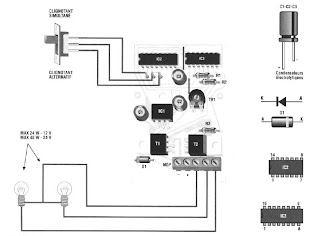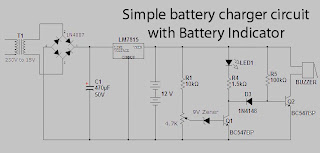SCHEMA BATTERY CHARGER Ni-Cd BATTERY AUTO
SCHEMA BATTERY CHARGER Ni-Cd:
It is a device that can charge any battery Ni-Cd between 4.8 and 1 4.4 Volts with a conventional car battery 1 2 volts. The charging current is constant it can be chosen from the values 1 50 20 mA by the selector S.
This device is very useful for lovers of model making, the video operator, those who use small reception issuance of appliances and all those who use Ni-Cd batteries and need to recharge or network voltage n ' is not available.
LIST OF ELECTRONIC COMPONENTS: All resistors are of 1/4 watt unless statedotherwise. R = 220Kohms R2 = 1 Kohm R3 = lKohm R4 = 120 ohm 1 watt R5 = 68 ohm 1 watt CI = 10 nF ceramic. C2 = 1000uF16Velec. C3 = 1000yF25Velec. D1 = 1N4001 ... 7 D2-1N4001 ... 7 D3-1N4001 ... 7 T1 = BDX53 T2 = BDX53 IC1 4047 = IC2 = 7805 1 selector 3 Heat Sinks 1 Support 14 pin
It is a device that can charge any battery Ni-Cd between 4.8 and 1 4.4 Volts with a conventional car battery 1 2 volts. The charging current is constant it can be chosen from the values 1 50 20 mA by the selector S.
This device is very useful for lovers of model making, the video operator, those who use small reception issuance of appliances and all those who use Ni-Cd batteries and need to recharge or network voltage n ' is not available.
LIST OF ELECTRONIC COMPONENTS: All resistors are of 1/4 watt unless statedotherwise. R = 220Kohms R2 = 1 Kohm R3 = lKohm R4 = 120 ohm 1 watt R5 = 68 ohm 1 watt CI = 10 nF ceramic. C2 = 1000uF16Velec. C3 = 1000yF25Velec. D1 = 1N4001 ... 7 D2-1N4001 ... 7 D3-1N4001 ... 7 T1 = BDX53 T2 = BDX53 IC1 4047 = IC2 = 7805 1 selector 3 Heat Sinks 1 Support 14 pin

























































